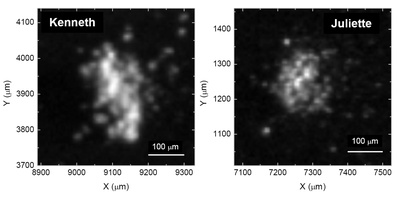Rosetta catches dusty organics
While organics had already been detected in situ on the comet’s surface by instruments on-board Philae and from orbit by Rosetta’s ROSINA , those were both in the form of gases resulting from the sublimation of ices. By contrast, COSIMA has made its detections in solid dust.
Their presence was only ever hinted at in previous comet missions, which flew by their targets at high speed and, as a result, disrupted the particles, making characterisation challenging. But Rosetta is orbiting Comet 67P/C-G and can catch dust particles moving at low speed.
“Our analysis reveals carbon in a far more complex form than expected,” remarked Hervé Cottin, one of the authors of the paper reporting the result that is published in Nature today. “It is so complex, we can’t give it a proper formula or a name!”
The organic signatures of seven particles are presented in the paper, which the COSIMA team say are representative of the two hundred plus grains analysed so far.
The carbon is found to be mixed with other previously reported elements such as sodium, magnesium, aluminium, silicon, calcium and iron. It is bound in very large macromolecular compounds similar to the insoluble organic matter found in carbonaceous chondrite meteorites that have fallen to Earth, but with a major difference: there is much more hydrogen found in the comet’s samples than in meteorites.
But as this kind of meteorite is associated with reasonably well-processed parent bodies such as asteroids, it is reasonable to assume that they lost their hydrogen due to heating. By contrast, comets must have avoided such significant heating to retain their hydrogen, and therefore must contain more primitive material.
From analyses of meteorites and laboratory simulations, the team was also expecting to identify a wide diversity of organic material in Comet 67P/C-G, ranging from very small molecules to heavy (or ‘high molecular weight’) organics.
Although Rosetta’s ROSINA and Philae’s PTOLEMY and COSAC instruments detected numerous low-molecular weight volatile organic molecules, COSIMA only saw very large carbon-bearing macromolecules in the dust particles, with nothing in between. This suggests potentially different sources for the lightweight volatile and heavier refractory carbonaceous material detected in the comet.
“Although we cannot know if the organics seen in these dust particles were created in the interstellar medium before the protoplanetary nebula came together, or in the protoplanetary disk during early Solar System formation, COSIMA’s dust grains are certainly witnesses to early formation processes, including that of the comet itself,” says Nicolas Fray, first author of the paper.
“These particles have remained pristine and untouched for billions of years until they were released in the days or weeks before being ‘caught’ by COSIMA,” adds Martin Hilchenbach, principal investigator of COSIMA. “The results add to the growing picture that Comet 67P/C-G contains some of the most primitive material from our Solar System’s early history.”
“High molecular weight organic matter in the particles of comet 67P/Churyumov-Gerasimenko” by N. Fray et al is published in Nature.
